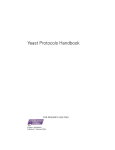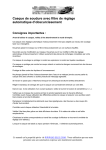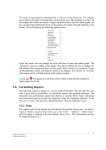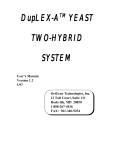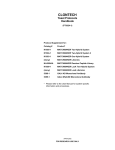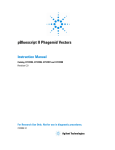Download Dokdo-PrepTM Plasmid DNA Mini-prep Kit User Manual
Transcript
Dokdo-PrepTM Plasmid DNA Mini-prep Kit User Manual Cat no. EBD-1001S & M Storage Conditions : Room Temperature For Research Use Only Technical Services: e-mail : [email protected] www.elpisbio.com ㈜ 엘피스바이오텍 ELPIS BIOTECH Overview The DokDo-PrepTM plasmid mini-prep kit provides a fast and simple way for bacterial plasmid DNA purification used for routine molecular biological applications. DokDo-PrepTM plasmid mini-prep kit contains chaotropic salt that enhances the binding of plasmid DNA onto a glass surface and reagents for alkaline lysis to purify plasmid DNA from bacteria. The column is packed with glass fiber filter and has enough surface area to bind up to 45 mg of plasmid DNA. Phenol extraction and ethanol precipitation are not required. Purified plasmid DNA is ready for restriction enzyme digestion, ligation, transformation, sequencing reactions, and library screening. The spin columns supplied in a spin-type kit (EBD-1001S) are packed with glass fiber filter and has enough surface area to bind up to 45 mg of plasmid DNA. The magnetic silica in a magnet-type kit (EBD-1001M) is useful for a batchtype purification procedure and helpful for magnet aided single step purification in various high-throughput applications. Phenol extraction and ethanol precipitation are not required. Purified plasmid DNA is ready for restriction enzyme digestion, ligation, transformation, sequencing reactions, and library screening. The kit can be used for centrifugation application. Kit Contents (EBD-1001S) Components Dokdo-PrepTM Amount Spin Column * Cell Resuspension Solution (Sol I) Cell Lysis Solution (Sol II) Neutralization Solution (Sol III) Wash Buffer** Elution Buffer RNase A Solution Manual Storage 200 ea Room Temperature 50 ml 50 ml 70 ml 20 ml x 2 20 ml 250 ml 1 ea Room Temperature Room Temperature Room Temperature Room Temperature Room Temperature 4℃ - * Dokdo-PrepTM Spin Column contains 2 ml collection tube ** Before use, add 80 ml of absolute ethanol (>98%) to 20 ml Wash Buffer. For other volumes of wash buffer, simply add enough ethanol to make a 4 : 1 ratio ( Ethanol volume : Wash Buffer volume ). Kit Contents (EBD-1001M) Components Amount Storage Magnetic Silica * 4 ml Room Temperature Cell Resuspension Solution (Sol I) Cell Lysis Solution (Sol II) Neutralization Solution (Sol III) Wash Buffer** Elution Buffer RNase A Solution Manual 50 ml 50 ml 70 ml 60 ml x 2 20 ml 250 ml 1 ea Room Temperature Room Temperature Room Temperature Room Temperature Room Temperature 4℃ - * Magnetic silica is supplied with 10% slurry. ** Before use, add 40 ml of absolute ethanol (>98%) to 60 ml Wash Buffer. For other volumes of wash buffer, simply add enough ethanol to make a 2: 3 ratio ( Ethanol volume : Wash Buffer volume ). Additional Materials Required Absolute ethanol (Molecular grade 98-100%) Table- top microcentrifuge capable of a 13,000xg centrifuge force Technical Services: e-mail : [email protected] www.elpisbio.com ㈜ 엘피스바이오텍 ELPIS BIOTECH Storage Condition DokDo-PrepTM plasmid mini-prep kits should be stored dry at room temperature (16 - 24℃). Kits can be stored for up to 12months without showing any reduction in performance and quality. After addition of RNase A, Cell Resuspension Solution (Sol I) should be stored at 2–8°C and is stable for six months. All other buffers and components and the RNase A stock solution can be stored for two years at room temperature without showing any reduction in performance, capacity, or quality of purification. Quality Control The performance of Dokdo-PrepTM plasmid mini-prep kit is monitored routinely on a lot number. This kit is tested with high-copy plasmid DNA from 3 ml overnight culture in LB medium and yield of plasmid DNA is measured with spectrophotometer. The quality of isolated DNA is checked by restriction digestion, agarose gel electrophoresis, and spectrophotometry by measuring absorbance at 230nm, 260nm, and 280nm. Important Notes for Dokdo-PrepTM Plasmid Mini-prep Kit Procedures Buffer notes (1) Cell Resuspension Solution (Sol I) Add the provided RNase A solution to Cell Resuspension Solution (Sol I), mix, and store at 2 - 8℃ The RNase A should retain activity for up to 6 months. After longer periods of storage, RNase A may not effectively eliminate RNA. In this case, add more RNase A solution. (2) Cell Lysis Solution (Sol II) Check Sol II before use whether salt precipitate. Redissolve any precipitate by warming to 37℃ . Do not shake vigorously. Close the bottle containing Sol II immediately after use to avoid acidification of Sol II from CO2 in the air. (3) Neutralization Solution (Sol III) Check Sol III before use whether salt precipitate. Redissolve any precipitate by warming to 37℃. (4) Wash Buffer Add absolute ethanol to Wash Buffer before use (see bottle label for volume). (5) RNase A Solution RNase A Solution should be stored dry at room temperature (2-8°C). For longer storage these can be kept at –20°C (6) Cell Lysis Solution (Sol II), Neutralization Solution (Sol III), Wash Buffer contain irritants. Wear gloves when handling these solutions ! Centrifugation notes All centrifugation steps are carried out at maximum speed (≥ 10,000xg or ~13,000 rpm) in a conventional, tabletop microcentrifuge. Elution notes (1) Ensure that the elution buffer is dispensed directly onto the center of the Dokdo-PrepTM Column membrane for optimal elution of DNA. (2) For increased DNA yield, use a higher elution-buffer volume. For increased DNA concentration, use a lower elution-buffer volume. (3) If water is used for elution, make sure that its pH is between 7.0 and 8.5. Store DNA at -20℃ when eluted with water, as DNA may degrade in the absence of a buffering agent. (4) DNA can also be eluted in TE (10 mM Tris-HCl, 1 mM EDTA, pH8.0), but the EDTA may inhibit subsequent enzymatic reactions. Technical Services: e-mail : [email protected] www.elpisbio.com ㈜ 엘피스바이오텍 ELPIS BIOTECH Protocols (EBD-1001S, Spin-type) 1. Transfer 1~10 ml overnight culture to a microcentrifuge tube. Centrifuge and discard the supernatant. Processing more cells can overload the cartridge system and result in lower plasmid DNA yield. Harvest 1~5 ml (high-copy-number plasmid) or 10 ml (low-copy number plasmid) of bacterial culture. 2. Add 250 ml of Cell Resuspension Solution (Sol I) and completely resuspend the cell pellet by vortexing well or pipetting. Ensure that RNase A has been added to Sol I. No cell clumps should be visible after resuspension of the pellet. Lysis efficiency highly depends on complete resuspension. 3. Add 250 ml of Cell Lysis Solution (Sol II) and gently invert the tube 4-6 times to mix. Do not allow the lysis reaction to proceed for more than 5 min. It is important to invert gently. Do not vortex, as this will result in shearing of genomic DNA. Over reaction may cause decreased supercoiled plasmid yield and increased production of nick form DNA. 4. Add 350 ml of Neutralization Solution (Sol III) and invert the tube immediately 4-6 times to mix. To avoid localized precipitation (white cell debris), mix the solution gently but thoroughly, immediately after addition of Neutralization Solution (Sol III). The solution should become cloudy. 5. Centrifuge at maximum speed (> 13,000rpm) for 10 min. 6. Place an Dokdo-PrepTM Column in a decent rack . 7. Transfer the cleared supernatant to the prepared Dokdo-PrepTM Column by decanting or pipetting 8. Centrifuge at maximum speed for 1 min. Discard the flow-through. 9. Wash the Dokdo-PrepTM Column by adding 750 ml of Wash Buffer. Repeat step 8. Add absolutely ethanol (96-100%) to Sol IV before use (see bottle label for volume). If salt or nuclease is remained in this step, add Wash Buffer, let stand for 2 minute at RT and then centrifuge for 1 min. 10. Centrifuge for an additional 1 min to remove residual Wash Buffer. Residual Wash Buffer in column membrane will not be completely removed unless the flow-through is discarded before this additional centrifugation. Residual ethanol from Washing Buffer may inhibit subsequent enzymatic reactions. 11. Place Dokdo-PrepTM Column in a fresh 1.5 ml microcentrifuge tube. 12. To elute DNA, add 50-100 ml of Elution Buffer or H2O to the center of each Dokdo-PrepTM Column, wait for 1 min, and centrifuge for 1 min. 13. Store the purified plasmid DNA at -20℃ or below. Technical Services: e-mail : [email protected] www.elpisbio.com ㈜ 엘피스바이오텍 ELPIS BIOTECH Protocols (EBD-1001M, Magnet-type) 1. Transfer 1~10 ml overnight culture to a microcentrifuge tube. Centrifuge and discard the supernatant. Processing more cells can overload the cartridge system and result in lower plasmid DNA yield. Harvest 1~5 ml (high-copy-number plasmid) or 10 ml (low-copy number plasmid) of bacterial culture. 2. Add 250 ml of Cell Resuspension Solution (Sol I) and completely resuspend the cell pellet by vortexing well or pipetting. Ensure that RNase A has been added to Sol I. No cell clumps should be visible after resuspension of the pellet. Lysis efficiency highly depends on complete resuspension. 3. Add 250 ml of Cell Lysis Solution (Sol II) and gently invert the tube 4-6 times to mix. Do not allow the lysis reaction to proceed for more than 5 min. It is important to invert gently. Do not vortex, as this will result in shearing of genomic DNA. Over reaction may cause decreased supercoiled plasmid yield and increased production of nick form DNA. 4. Add 350 ml of Neutralization Solution (Sol III) and invert the tube immediately 4-6 times to mix. To avoid localized precipitation (white cell debris), mix the solution gently but thoroughly, immediately after addition of Neutralization Solution (Sol III). The solution should become cloudy. 5. Centrifuge at maximum speed (> 13,000rpm) for 10 min. 6. Transfer the cleared supernatant to a fresh tube by decanting or pipetting. 7. Add 20 ml of magnetic silica solution to cleared lysate and mix briefly. Before addition, magnetic silica solution should be mixed well by brief agitation. 8. Stand tube at room temperature for 3 min with occasional gentle agitation. If DNA binds to silica bead, black aggregates of magnetic beads may form. 9. Centrifuge at maximum speed for 30 sec. Discard the flow-through. 10. Wash the magnetic beads by 750 ml of Wash Buffer. Repeat step9. Add absolutely ethanol (96-100%) to Wash Buffer before use. 11. Completely remove residual Wash Buffer by drying at room temperature or 55 ℃. Residual Wash Buffer will not be completely removed unless the flow-through is discarded before this additional centrifugation. Residual ethanol from Washing Buffer may inhibit subsequent enzymatic reactions and result in floating of gel loading solution in agarose analysis step. Over drying of magnetic silica/DNA complex may result in significant reduction in purification yield with a difficulty in bead resuspension. 12. To elute DNA, add 10-100 ml of Elution Buffer or H2O to tube, vortex for 30 sec, and centrifuge for 1 min. 13. Store the purified plasmid DNA at -20℃ or below. Hint : Appropriate scaling of purification volume should be determined for set-up of high-throughput purification using multiwell plates with a magnet device or centrifugal force by user’s purpose. You can also use magnet device instead of centrifuge. Technical Services: e-mail : [email protected] www.elpisbio.com ㈜ 엘피스바이오텍 ELPIS BIOTECH Fig.1. 3 kbp (pBluescript) , 10 kbp (pLexA) Plasmid Mini-prep Comparison M 1 2 3 4 5 M 6 7 8 9 Analyzed on a 0.7% agarose 10 M : 1Kbp DNA ladder marker (supercoil) EBM-1011 Lane 1-5 : pBluescript II SK(-) (3 kbp) 6-10 : pLexA (10 kbp) Lane 1, 6 . Alkaline lysis method : Molecular cloning Maniatis method 2, 7. Silica gel usage prep 3, 8. Other company (Q company) DNA mini-prep kit 4, 9. Other company (B company) DNA mini-prep kit 5, 10. Dokdo-PrepTM plasmid prep kit Fig.2. Quality test : Restriction Enzyme Digestion M1 1 2 3 4 5 6 7 8 9 10 M2 11 12 M1 M2 M3 1. Purified plasmid DNA : pET28a - insert (250 bp-1.2 kbp) clone 2. Restriction enzyme cutting : BamH I / Hind III - 37℃, 1 hr cutting 3. Result Analyzed on a 1.0 % agarose lane 1 - 12. pET 28a insert ( 250 bp -1.2 kbp) M1. 100bp DNA marker (EBM-1001) M2. 1Kbp pus 100bp DNA ladder marker (EBM-1003) M3. 1Kbp DNA ladder marker (supercoil) (EBM-1011) Fig. 3. Elution Volume vs. Concentration of Plasmid DNA and Recovery Yield (DNA : pRS 5 kbp) Elution volume vs. recovery Elution volume vs. DNA conc 350 100 90 300 DNA (mg/ml) Recovery (%) 80 70 60 50 40 30 250 200 150 100 20 50 10 0 0 10 20 30 40 50 100 Elution volume (ml) 150 10 20 30 40 50 Elution volume (ml) 100 150 Fig. 4. Sequencing Result Data of Purified Plasmid DNA. Table 1. Comparative Results : Yield vs. Purity Mini-prep Kits O.D. value 260/230nm 260/280nm DNA conc (mg/ml) Total DNA (mg) 0.0049 - 1.897 46.5 4.65 0.0100 0.0056 - 1.785 50.0 5 0.0045 0.0182 0.0098 4.0 1.857 91.0 9.1 0.0049 0.0181 0.0096 3.7 1.895 91.0 9.1 (culture volume) 230nm 260nm 280nm Elpis-Biotech (1.5 ml) 0 0.0093 Brand Q (1.5 ml) 0 Elpis-Biotech (3 ml) Brand Q (3 ml) Technical Services: e-mail : [email protected] www.elpisbio.com ㈜ 엘피스바이오텍 ELPIS BIOTECH Troubleshooting Guide Question 1. No yield of Plasmid DNA <Check1> Ethanol is not added to the Column Wash Buffer. Prepare the Column Wash buffer as instructed before beginning the procedure. <Check 2> Transformed bacteria should be inoculated in medium containing the appropriate antibiotic. Antibiotic selection should be applied at all stages of growth. Many plasmids in use today do not contain the par locus which ensures that the plasmids segregate equally during cell division. Daughter cells that do not receive plasmids will replicate much faster than plasmid-containing cells in the absence of selective pressure, and can quickly take over the culture. The stability of the selective agent should also be taken into account. Resistance to ampicillin, for example, is mediated by β-lactamase which is encoded by the plasmid linked bla gene and which hydrolyzes ampicillin. Levels of ampicillin in the culture medium are thus continually depleted. This phenomenon is clearly demonstrated on ampicillin plates, where satellite colonies appear as the ampicillin is hydrolyzed in the vicinity of a growing colony. Ampicillin is also very sensitive to temperature, and when in solution should be stored frozen in single-use aliquots. The recommendations given in Table 2 are based on these considerations. Table 2. Concentrations of commonly used antibiotics Stock solution Ampicillin (sodium salt) Chloramphenicol Kanamycin Streptomycin Tetracycline HCl 50 mg/ml in H2O 34 mg/ml in ethanol 10 mg/ml in H2O 10 mg/ml in H2O 5 mg/ml in ethanol Working solution 100 mg/ml 170 mg/ml 50 mg/ml 50 mg/ml 50 mg/ml Storage -20℃ -20℃ -20℃ -20℃ -20℃ Question 2. Low plasmid DNA yield The yield and quality of prepared plasmid DNA may depend on factors such as plasmid copy number, host strain, inoculation, antibiotic, and type of culture medium. <Check 1> Low copy number plasmid used. Plasmids vary widely in their copy number per cell, depending on their origin of replication (e.g., pMB1, ColE1, or pSC101) that determines whether they are under relaxed or stringent control; and depending on the size of the plasmid and its associated insert. Some plasmids, such as the pUC series and derivatives, have mutations that allow them to reach very high copy numbers within the bacterial cell. Plasmids based on pBR322 and cosmids are generally present in lower copy numbers. Very large plasmids and cosmids are often maintained at very low copy numbers per cell. <Check 2> Bacterial cultures too old or overgrowth Bacterial cultures for plasmid preparation should always be grown from a single colony picked from a freshly streaked selective plate. Subculturing directly from glycerol stocks, agar stabs, and liquid cultures is poor microbiological practice and may lead to uneven plasmid yield or loss of the plasmid. Inoculation from plates that have been stored for a long time may also lead to loss or mutation of the plasmid. The desired clone should be streaked from a glycerol stock onto a freshly prepared agar plate containing the appropriate selective agent so that single colonies can be isolated. This procedure should then be repeated to ensure that a single colony of an antibioticresistant clone could be picked. A single colony should be inoculated into 1.5 ml of media containing the appropriate selective agent, and grown with vigorous shaking for 12-16 hours. Growth for more than 16 hours is not recommended since cells begin to lyses and plasmid yields may be reduced. <Check 3> Poor resuspension of bacterial cell pellet The cell pellet must be thoroughly resuspended prior to cell lysis. Pellet or disperse the pellet with the Cell Resuspension Solution (Sol I). No clumps should be visible after resuspension. The use of rich media or excessive culture volumes may lead to a biomass value too high for complete lysis. If these media are used, recommended culture volumes must be reduced to match the capacity of the Dokdo-PrepTM plasmid mini-prep membrane. If too much culture volume is used, alkaline lysis will be inefficient, the plasmid mini-prep membrane will be overloaded, and the performance of the system will be unsatisfactory. Technical Services: e-mail : [email protected] www.elpisbio.com ㈜ 엘피스바이오텍 ELPIS BIOTECH <Check 4> Elution buffer incorrect or incorrectly dispensed onto membrane Add elution buffer to the center of the Dokdo-PrepTM membrane to ensure that the buffer completely covers the surface of the membrane for maximum elution efficiency. DNA is eluted only in the presence of low-salt buffer, e.g., Elution buffer or H2O. Elution efficiency is dependent on pH. The maximum efficiency is achieved between pH7.0 and 8.5. When using water for elution, make sure that the pH value is within this range. Plasmid yield with the Dokdo-PrepTM plasmid mini-prep kit varies depending on the elution volume (Figure 3.). If necessary, elution buffer volume control according to user’s purpose Related Products Dokdo-PrepTM Plasmid Mini-prep Kit (spin-type) EBD-1001S Dokdo-PrepTM Plasmid Mini-prep Kit (magnet-type) EBD-1001M Dokdo-PrepTM PCR Purification Kit EBD-1004 Dokdo-PrepTM Gel Extraction Kit (spin-type) EBD-1005 Dokdo-PrepTM Gel extraction Kit (bead-type) EBD-1006 Dokdo-PrepTM Bacterial genomic DNA Purification Kit EBD-1007 Dokdo-PrepTM Blood genomic DNA Purification Kit EBD-1008 Customer & Technical Services For technical assistance and more information please call one of the Elpis-Biotech., Inc. Tel : +82-42-581-8448 Fax : +82-42-581-8449 E-mail : [email protected] Trademarks Dokdo-PrepTM and One•QueTM are trademarks of Elpis-Biotech., Inc. Technical Services: e-mail : [email protected] www.elpisbio.com ㈜ 엘피스바이오텍 ELPIS BIOTECH









